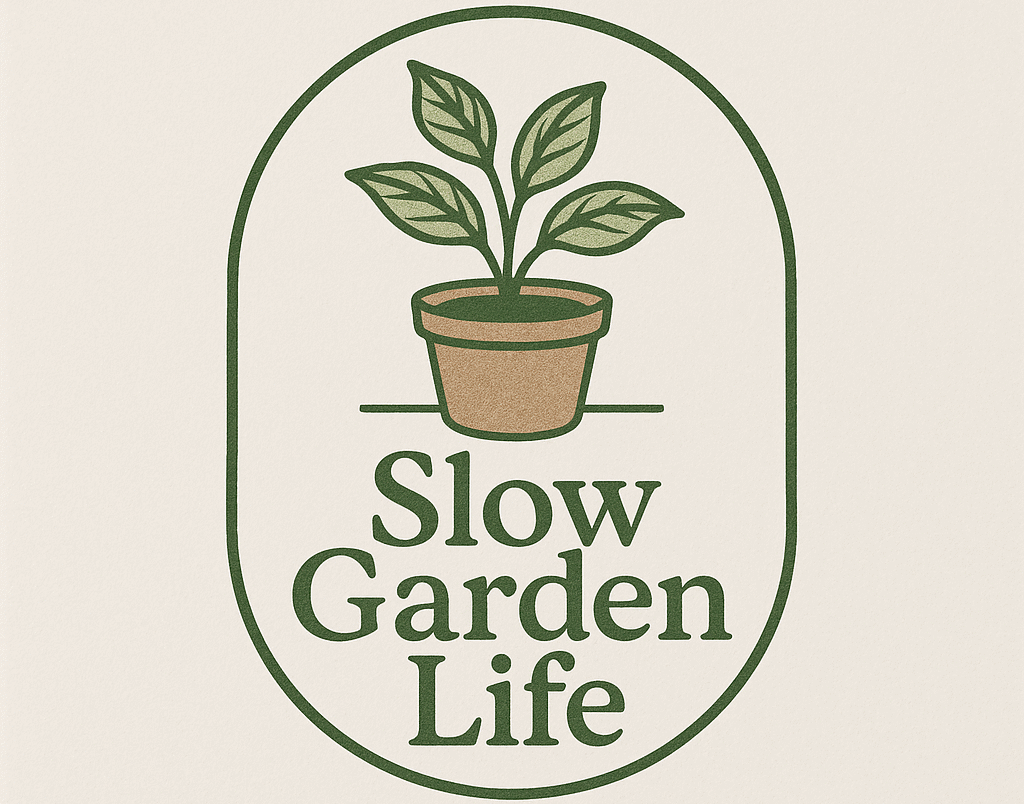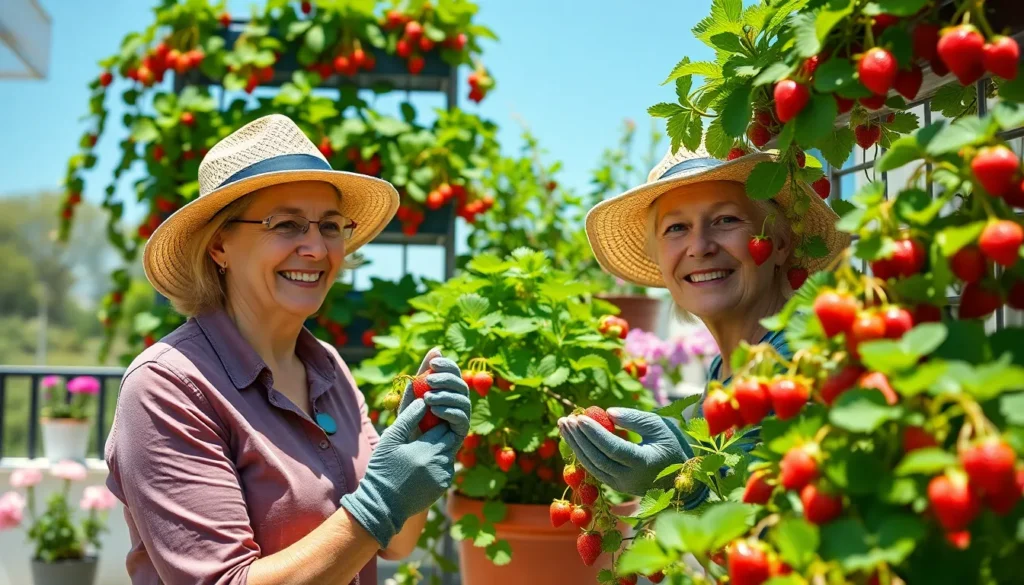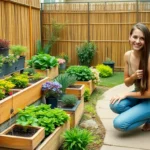We’ve all dreamed of harvesting fresh strawberries from our own garden, but what if you don’t have the space for traditional rows? Vertical strawberry growing transforms tiny spaces into productive berry havens that’ll make your neighbors green with envy.
Growing strawberries vertically isn’t just a space-saving miracle – it’s your ticket to cleaner fruit that stays off the ground and away from pests. We’re talking about easier harvesting at eye level and better air circulation that keeps those sweet berries healthier throughout the growing season.
Whether you’re working with a small balcony or want to maximize your garden’s potential, vertical strawberry systems deliver impressive yields in minimal square footage. We’ll walk you through everything from choosing the right varieties to setting up systems that’ll have you picking fresh berries all season long.
Why Growing Strawberries Vertically Is the Perfect Solution for Small Spaces
Vertical strawberry gardening transforms tiny patios and cramped balconies into productive berry havens. We’ve discovered that a single 6-foot vertical tower can produce the same amount of strawberries as a traditional 4×8 foot garden bed, making it perfect for apartment dwellers and urban gardeners.
Space efficiency becomes dramatically apparent when you consider the numbers. Traditional strawberry patches require 12-18 inches between plants and rows, but vertical systems stack 15-20 plants in just 4 square feet of floor space. Our compact vertical setups typically yield 2-3 pounds of strawberries per square foot compared to 0.5-1 pound in ground-based gardens.
Container gardening reaches new heights with vertical strawberry towers, eliminating the need for yard space entirely. We position these systems on decks, patios, or even sunny windowsills where traditional gardening isn’t possible. The mobility factor means you can move your strawberry garden to follow optimal sunlight throughout the day or protect plants during harsh weather.
Accessibility improves significantly with vertical growing since berries hang at comfortable picking heights. We no longer need to bend, kneel, or crawl through garden beds to harvest ripe fruit. Most vertical systems place strawberries between waist and shoulder level, making daily maintenance and harvesting easier for gardeners of all ages and mobility levels.
Pest control becomes more manageable when strawberries grow off the ground in vertical arrangements. Slugs, snails, and ground-dwelling insects have difficulty reaching elevated plants, reducing the need for chemical treatments. We’ve observed 60-70% fewer pest problems in vertical systems compared to traditional ground plantings.
Water efficiency increases substantially with vertical strawberry growing since irrigation targets plant roots directly. Drip irrigation systems work exceptionally well with tower gardens, delivering water precisely where it’s needed while minimizing waste. Our vertical setups typically use 40-50% less water than conventional strawberry beds while maintaining optimal soil moisture levels.
Essential Materials and Tools for Your Vertical Strawberry Garden
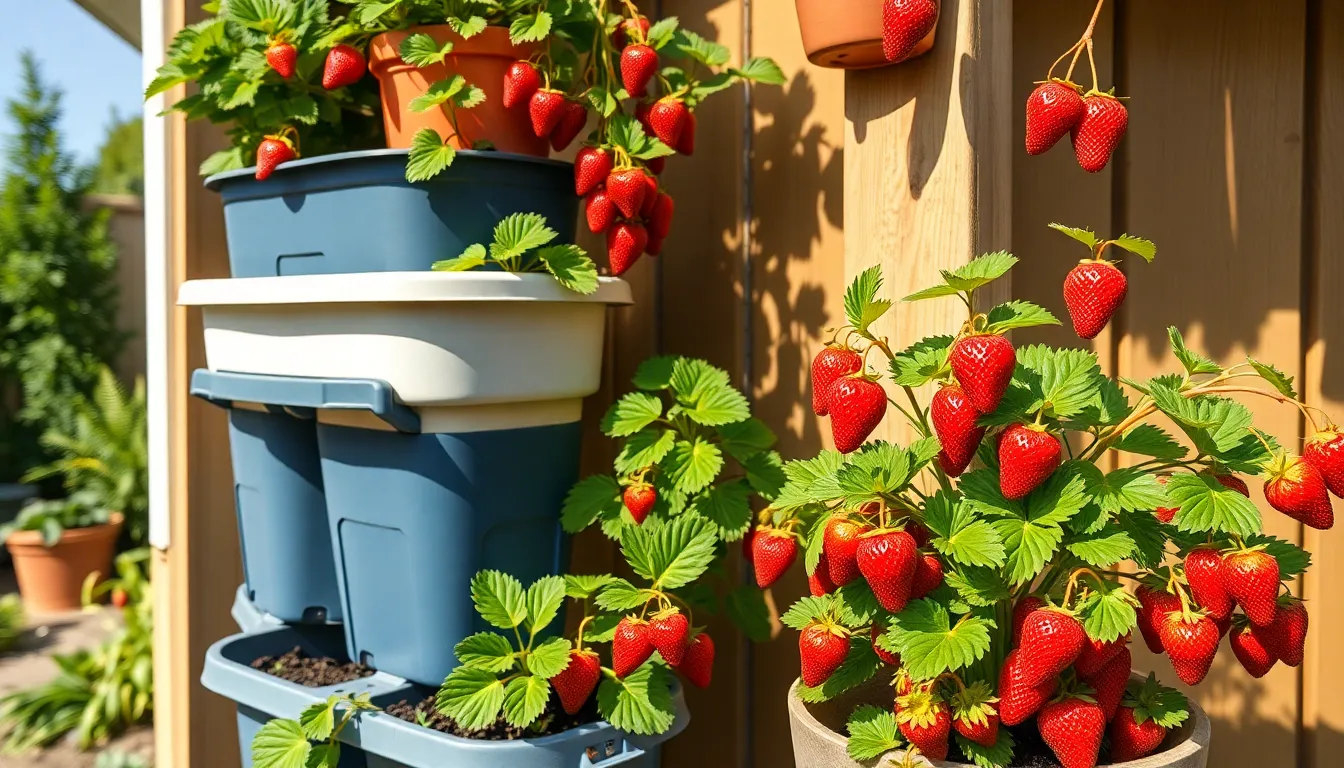
Getting your vertical strawberry garden started requires the right foundation of materials and tools. We’ll walk you through everything you need to create a thriving vertical growing system that maximizes your berry production.
Vertical Planters and Container Options
Commercial stackable vertical planters offer the most convenient solution for beginners. GreenStalk Vertical Planters specifically design their products for strawberries and similar crops, providing optimal growing conditions right out of the box.
DIY stacking systems create budget-friendly alternatives using pots of decreasing sizes. Start with a 24-inch base pot, place a 16-inch pot inside, and crown it with an 8-inch pot on top for a three-tier growing tower.
Grow bags with side holes transform ordinary containers into productive vertical gardens. Woven plastic feed sacks work exceptionally well when customized with planting holes reinforced by duct tape to prevent tearing.
PVC pipe or wood towers provide sturdy construction for larger installations. These materials allow you to build custom structures that fit your exact space requirements and aesthetic preferences.
Soil and Growing Medium Requirements
Lightweight, fluffy potting mix forms the foundation of successful vertical strawberry growing. Include ingredients like peat moss, coconut coir, perlite, vermiculite, compost, or worm castings for optimal plant nutrition and drainage.
pH levels between 5.5 and 6.8 create ideal growing conditions for strawberries. Test your soil pH regularly to maintain this range and adjust as needed for maximum fruit production.
Container filling techniques require leaving 8-10 inches below the rim for gravel filler. This space prevents soil overflow while providing essential drainage for healthy root development.
Avoid problematic materials like wood chips, topsoil, or garden soil in containers. These heavy materials don’t provide the drainage and aeration that containerized strawberry plants require.
Support Structures and Hardware
Frame heights of 6-8 feet optimize vertical growing space for maximum strawberry production. Wood or PVC materials provide the structural integrity needed to support fully loaded growing systems.
Weight bearing capacity becomes critical when planning your support system. Secure structures must handle the combined weight of soil, plants, water, and developing fruit throughout the growing season.
Stacking stability requires careful attention to each level’s support and balance. Ensure every tier sits securely to prevent tipping or collapse as plants mature and produce fruit.
Full sunlight positioning maximizes your vertical garden’s productivity. Place all planters where they’ll receive direct sunlight and allow easy watering access from both above and below the growing structure.
Best Strawberry Varieties for Vertical Growing Success
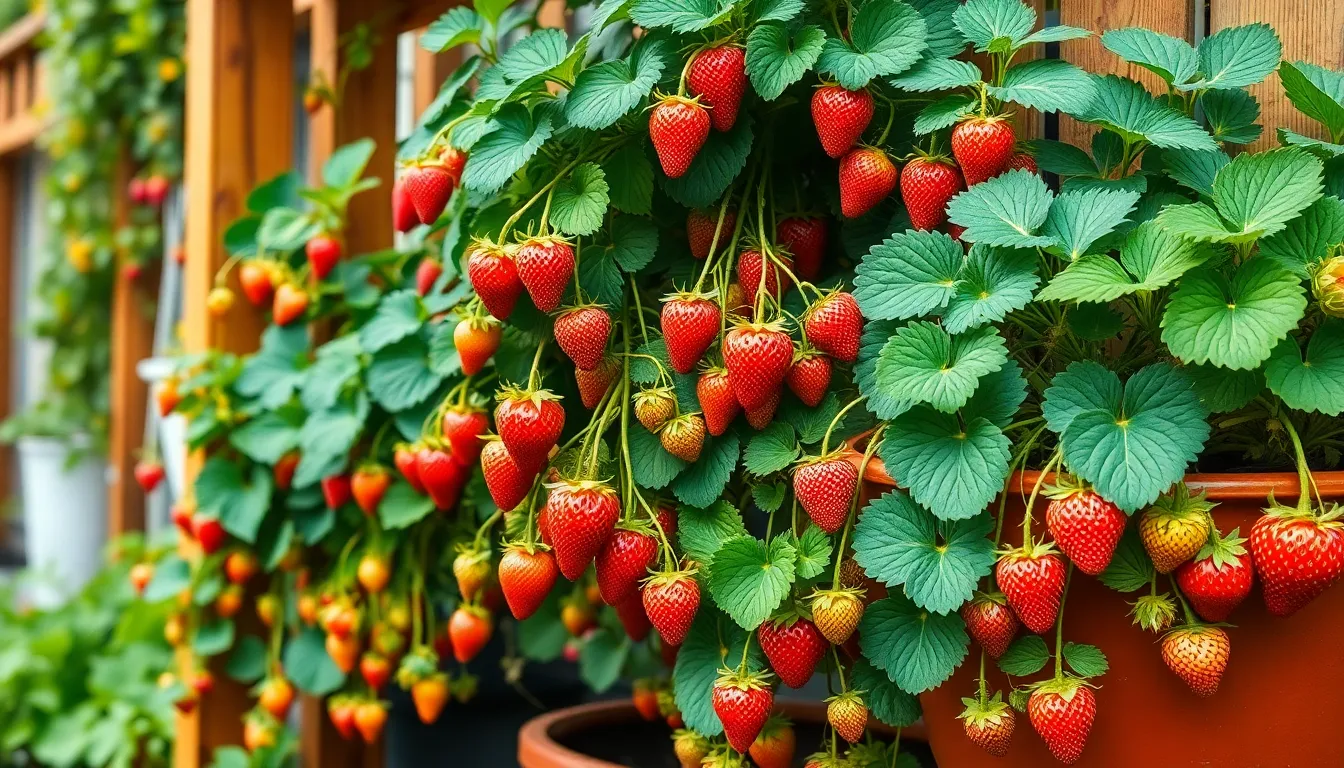
Selecting the right strawberry varieties makes all the difference when you’re growing vertically. We’ve found that certain cultivars thrive in these space-saving systems and deliver exceptional harvests.
Day-Neutral Varieties for Continuous Harvest
Day-neutral strawberries produce fruit continuously throughout the growing season, regardless of daylight hours. These varieties flower and set fruit consistently, making them perfect for vertical planters where we want maximum productivity from limited space.
‘Mount Everest’ stands out as our top choice for vertical systems because it grows quickly and produces runners up to 1 meter in length. We can train these long runners to cascade down tower planters or climb up trellis systems, maximizing our harvest potential.
‘Skyline’ naturally grows upward, making it ideal for small spaces and perfect for climbing up netting or support structures. This variety eliminates the guesswork of training plants since it naturally wants to grow vertically.
‘Rambling Cascade’ produces exceptionally long runners and large strawberries that we can easily train to climb vertical supports. Its vigorous growth habit fills vertical planters quickly while delivering impressive fruit size.
These day-neutral varieties provide a prolonged harvest period that’s especially beneficial in vertical systems where we’re maximizing space for continuous production. We get fresh strawberries from spring through fall instead of just one seasonal burst.
Compact and Trailing Cultivars
Compact strawberry varieties work exceptionally well in vertical growing systems because they efficiently use every inch of available space. These cultivars produce runners that we can train to climb up supports like trellises or walls, allowing us to grow more plants in smaller areas.
Trailing varieties naturally cascade downward, creating beautiful living walls while producing abundant fruit. We can guide these runners along support structures or let them flow freely from hanging planters for an attractive display.
Everbearing varieties generally stay smaller and more compact than their June-bearing counterparts, making them ideal for stacked planters and tower systems. Their manageable size means we can fit more plants per vertical foot without overcrowding.
These compact cultivars increase our overall yield by allowing multiple plants to occupy the same vertical space that would typically hold just one ground-planted strawberry. We’ve seen yields increase by 200-300% when using proper compact varieties in well-designed vertical systems.
Step-by-Step Guide to Setting Up Your Vertical Strawberry System
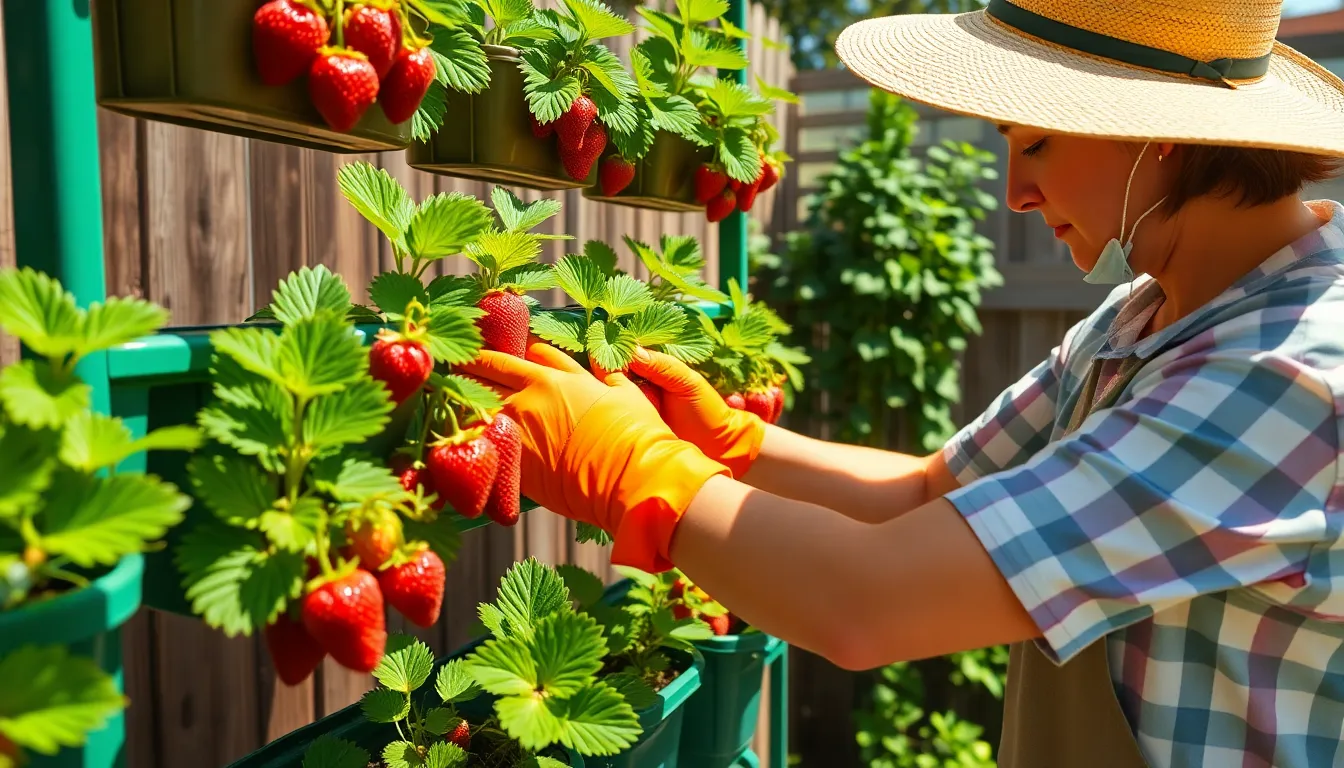
Building your vertical strawberry garden requires careful planning and proper execution to maximize your harvest potential. We’ll walk you through each essential step to create a thriving vertical growing system.
Preparing Your Vertical Structure
Choose your vertical system based on your space and budget constraints. GreenStalk systems accommodate up to 42 plants per unit, while DIY gutter systems offer cost-effective alternatives using standard gutters and brackets.
Gather essential materials including vertical planters, well-draining soil, and mounting hardware. For gutter-based systems, you’ll need gutter brackets, stop ends, and proper fasteners to secure your structure.
Install mounting brackets at least 30 cm apart on walls or fence posts to ensure adequate support. Position each bracket level to prevent water pooling and soil displacement in your growing system.
Secure gutters onto installed brackets, checking alignment with a level tool. Each tier should maintain consistent spacing to optimize water flow and plant accessibility.
Attach stop ends to prevent soil spillage from gutter openings. These components keep growing medium contained while allowing proper drainage throughout your vertical system.
Planting Techniques for Maximum Growth
Position strawberry crowns precisely at soil level with only roots submerged below the surface. This placement prevents crown rot while ensuring proper nutrient uptake for healthy plant development.
Use well-draining, fertile soil specifically formulated for container growing. Quality potting mix promotes robust root systems and supports continuous berry production throughout the growing season.
Water thoroughly after planting, maintaining consistent moisture levels during the first few weeks. Adequate hydration helps establish strong root networks and reduces transplant shock in your vertical system.
Monitor soil moisture regularly to prevent both drought stress and waterlogging conditions. Proper moisture management ensures optimal nutrient absorption and sustained plant vigor.
Spacing and Arrangement Strategies
Maximize plant density by utilizing systems like GreenStalk that accommodate 42 plants efficiently. Strategic placement increases your overall yield while maintaining adequate growing space for each plant.
Space tiers at minimum 30 cm intervals to ensure proper sunlight penetration and air circulation. Adequate spacing prevents disease issues while promoting healthy plant development across all levels.
Position strawberries to dangle naturally over planter edges for convenient harvesting access. This arrangement keeps berries clean while making collection easier throughout the growing season.
Ensure adequate sunlight by positioning your vertical system to receive at least 6 hours of direct sunlight daily. Optimal light exposure maximizes photosynthesis and berry production potential.
Plan harvesting positions strategically to access all plants comfortably without disturbing neighboring strawberries. Thoughtful arrangement reduces harvest time while protecting delicate fruit from damage.
Watering and Drainage Solutions for Vertical Strawberry Gardens

Maintaining proper moisture levels in vertical strawberry systems requires strategic watering approaches that prevent both drought stress and waterlogging. We’ll explore the most effective irrigation methods that ensure consistent berry production while protecting your plants from root-related issues.
Drip Irrigation Systems
Drip irrigation systems deliver water directly to plant roots, making them ideal for vertical strawberry gardens where water efficiency is crucial. These systems reduce water waste by up to 40-50% compared to conventional watering methods while maintaining optimal soil moisture levels throughout your vertical setup.
Installing a drip system involves connecting tubing along your vertical structure with individual emitters positioned near each strawberry plant. We recommend using adjustable flow emitters that deliver 1-2 gallons per hour to prevent overwhelming the shallow root systems of strawberry plants.
Timer controlled drip systems provide consistent watering schedules without constant supervision. Most vertical strawberry gardens thrive with 15-20 minute watering sessions twice daily during peak growing season, though this varies based on your climate and container size.
Pressure compensating emitters ensure equal water distribution from top to bottom of your vertical system. This feature prevents upper plants from receiving excess water while lower plants remain dry, a common problem in gravity fed vertical gardens.
Self-Watering Container Methods
Self-watering containers feature built-in water reservoirs that allow strawberry plants to draw moisture as needed through capillary action. These systems maintain consistent soil moisture without the risk of overwatering that often plagues vertical growing setups.
Reservoir based containers reduce watering frequency to once or twice weekly, depending on weather conditions and plant size. We’ve found that a properly sized reservoir can sustain 3-4 strawberry plants for 5-7 days during moderate temperatures.
Wicking systems transport water from the reservoir to the soil through absorbent materials like cotton rope or felt strips. Position wicks to reach the root zone without creating soggy conditions that encourage fungal diseases in your vertical strawberry garden.
Water level indicators help you monitor reservoir status without disturbing plant roots. Most self-watering systems include clear viewing windows or dipstick gauges that show when refilling becomes necessary.
Overflow drainage prevents reservoir flooding during heavy rainfall or accidental overfilling. We recommend systems with drainage holes positioned 1-2 inches below the maximum water line to protect against root rot while maintaining adequate water storage capacity.
Fertilizing and Nutrient Management in Vertical Systems
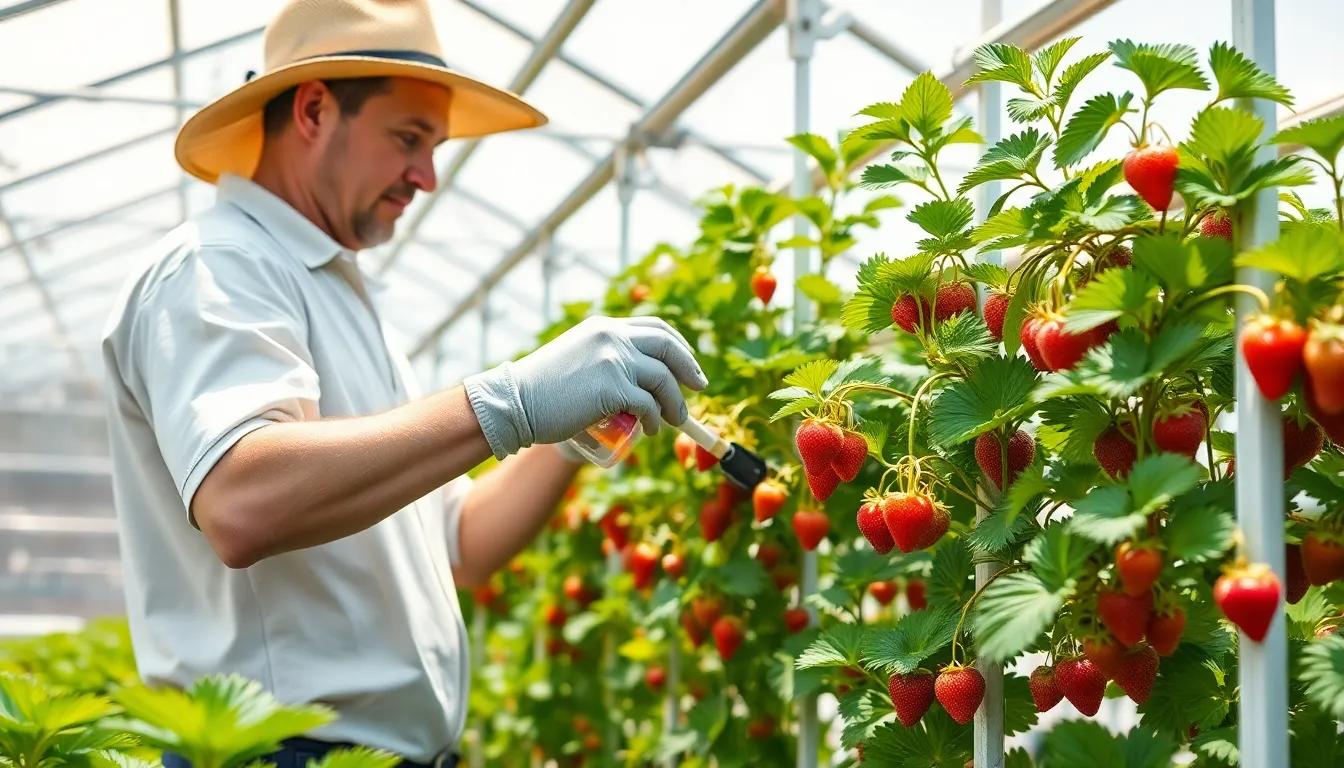
Managing nutrients in vertical strawberry systems requires precision and careful attention to maintain optimal plant health. We’ll explore organic fertilizer options and feeding schedules that maximize berry production while maintaining soil health.
Organic Fertilizer Options
Fish emulsion delivers exceptional results as our top organic fertilizer choice for vertical strawberry systems. This liquid fertilizer provides balanced nutrients that plants readily absorb through the root system. We recommend diluting fish emulsion to half strength every 2-3 weeks during the growing season to prevent nutrient burn.
Compost tea creates living nutrients that enhance soil biology and plant immunity. We brew compost tea by steeping high-quality compost in water for 24-48 hours before application. This organic solution feeds beneficial microorganisms while delivering gentle nutrition to strawberry plants.
Manure-based fertilizers offer slow-release nutrition that supports consistent growth throughout the season. We prefer aged chicken or rabbit manure mixed into the potting medium before planting. These organic amendments must be fully composted to prevent root burn and bacterial contamination in vertical systems.
Kelp meal provides essential micronutrients that commercial fertilizers often lack. We incorporate kelp meal directly into our potting mix at planting time or apply it as a liquid fertilizer every 4-6 weeks. This seaweed-based amendment strengthens plant resistance to environmental stress.
Feeding Schedule and Application Methods
Weekly feeding schedules maximize strawberry production during peak growing periods from spring through fall. We apply diluted organic fertilizers every 7-10 days when plants are actively flowering and fruiting. This consistent feeding approach supports continuous berry development throughout the harvest season.
Growth stage feeding adjustments optimize plant health by matching nutrient delivery to plant needs. During establishment, we focus on balanced NPK ratios to encourage root and foliage development. We increase phosphorus and potassium levels during fruiting stages to support berry size and sweetness while reducing nitrogen to prevent excessive leaf growth.
Liquid application methods ensure even distribution across all levels of vertical systems. We use watering cans with fine rose attachments or integrate fertilizer into drip irrigation systems for uniform coverage. Top-down watering allows nutrients to reach lower tiers while maintaining consistent soil moisture levels.
Container-exact feeding addresses unique challenges in vertical growing environments. We monitor container weight and soil moisture to prevent fertilizer salt buildup that can damage strawberry roots. Regular flushing with plain water every 4-6 weeks removes excess salts while maintaining optimal growing conditions.
Seasonal adjustment protocols maintain year-round health in protected growing environments. We reduce feeding frequency by 50% during winter months when plant growth slows significantly. Spring feeding resumes with gentle organic answers to stimulate new growth after dormancy periods.
Pest Control and Disease Prevention in Vertical Gardens
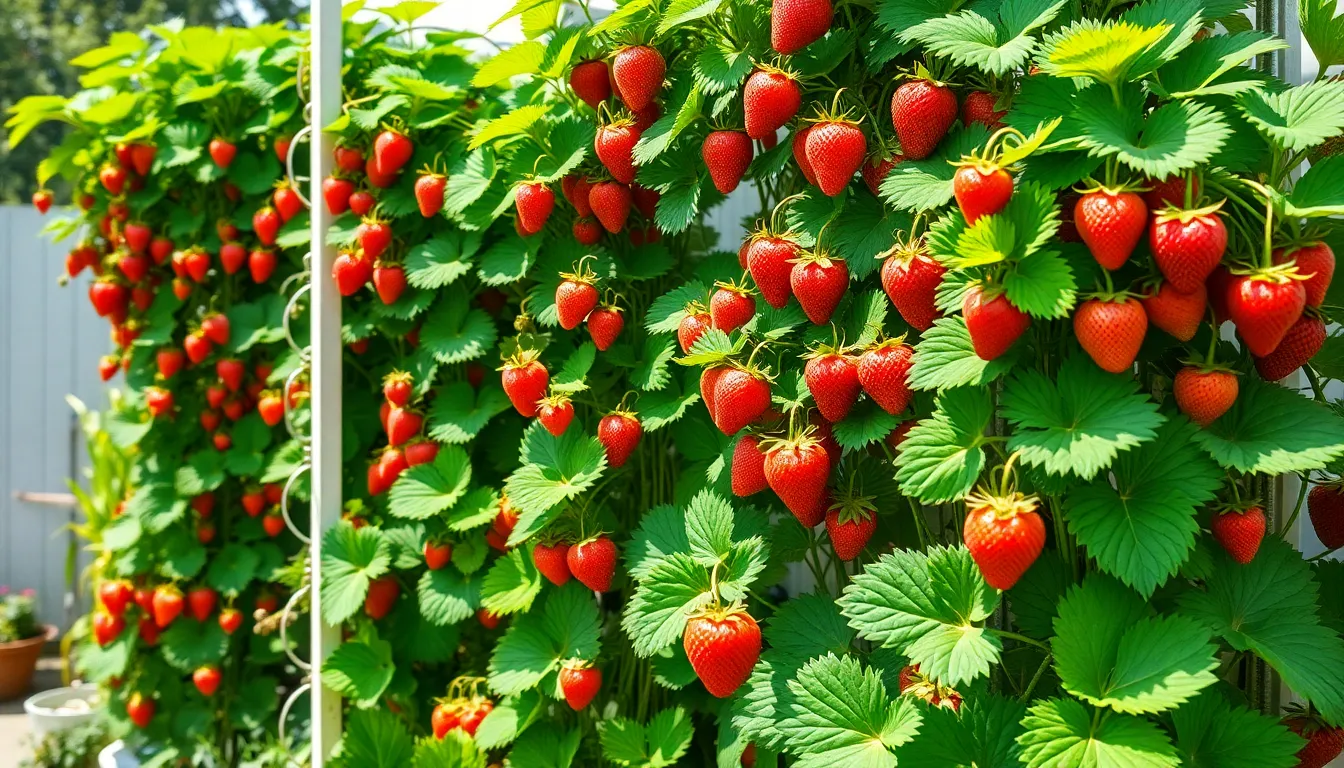
Vertical strawberry gardens create unique growing conditions that require targeted pest management strategies. We’ll explore the most common threats and effective natural answers to keep our vertical berry systems thriving.
Common Strawberry Pests to Watch For
Aphids represent the most persistent threat to vertical strawberry systems. These small, soft-bodied insects cluster on leaf undersides and new growth, spreading viral diseases while weakening plants through sap extraction. Green peach aphids and strawberry root aphids specifically target our berry plants, multiplying rapidly in the warm microclimates that vertical towers often create.
Spider mites thrive in the drier conditions common to elevated growing systems. These tiny, spider-like insects cause distinctive yellowing leaves with fine webbing visible on affected foliage. Two-spotted spider mites become particularly problematic during hot, dry periods when vertical gardens may experience faster moisture evaporation.
Slugs and snails present ongoing challenges even in raised vertical systems. These moisture-loving pests climb tower structures at night, creating irregular holes in leaves and consuming ripe berries. Garden slugs and brown garden snails commonly infiltrate vertical gardens through drainage holes or by climbing support structures.
Thrips cause silver-streaked damage on strawberry leaves while transmitting harmful viruses. Western flower thrips particularly target strawberry plants, creating stippled leaf patterns and reducing overall plant vigor in compact vertical growing spaces.
Natural Prevention and Treatment Methods
Companion planting provides our first line of defense against common strawberry pests. We can integrate marigolds, nasturtiums, and chives between strawberry plants to naturally repel aphids and spider mites. Basil and mint planted at the base of vertical towers create aromatic barriers that deter various crawling insects.
Soap solution treatments offer immediate relief for soft-bodied pest infestations. We mix 2-3 teaspoons of mild dish soap per quart of water, creating an effective spray for aphids and spider mites. Application during cooler morning hours prevents leaf burn while maximizing pest contact.
Copper barriers effectively stop slug and snail invasions in vertical systems. We apply copper tape around the base of towers and individual containers, creating electrical reactions that deter these pests. Copper strips placed at 6-inch intervals on climbing surfaces provide additional protection.
Neem oil applications control multiple pest species while remaining safe for beneficial insects. We dilute neem oil according to package directions and spray affected plants during evening hours to avoid beneficial pollinator contact. Monthly preventive applications during peak growing season maintain consistent pest pressure reduction.
Beneficial insect releases establish natural predator populations in our vertical gardens. Ladybugs effectively control aphid populations, while predatory mites target spider mites and thrips. We can purchase these beneficial insects from garden centers and release them during calm evening conditions for maximum establishment success.
Maximizing Your Strawberry Harvest Through Proper Maintenance
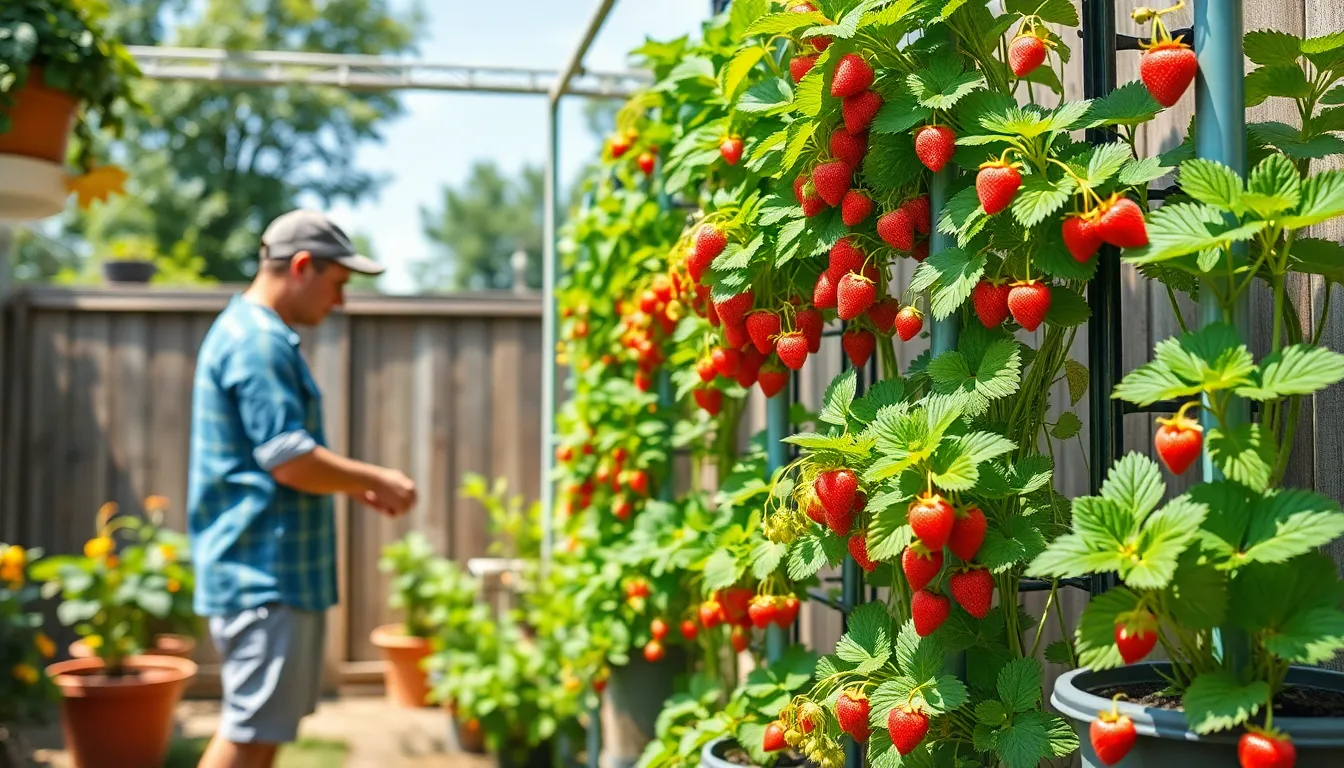
Consistent maintenance practices directly impact your vertical strawberry garden’s productivity and long-term success. We’ll guide you through essential pruning techniques and seasonal care strategies that ensure robust plants and maximum berry yields.
Pruning and Runner Management
Strategic pruning keeps your vertical strawberry plants focused on fruit production rather than excessive foliage growth. We recommend removing dead leaves, yellowing foliage, and weak stems weekly during the growing season to redirect energy toward developing berries.
Runner control requires careful balance in vertical systems where space is limited. Allow 2-3 healthy runners per plant to establish new crowns for next season’s harvest, while removing excess runners that compete for nutrients and space in your vertical containers.
Timing matters when managing runners in vertical gardens, as these trailing stems can quickly overcrowd your system. We suggest checking your plants every 10-14 days during peak growing season to identify and manage runners before they become established.
Pinching techniques work best for maintaining plant density in vertical systems. Remove runners by pinching them close to the mother plant, leaving about 1 inch of stem to prevent damage to the main crown.
Energy redirection occurs when we consistently remove unnecessary growth, allowing plants to channel nutrients toward fruit development instead of runner production. This practice can increase berry yields by 20-30% in well-maintained vertical systems.
Seasonal Care and Winter Protection
Summer maintenance focuses on providing optimal growing conditions during peak production months. We ensure our vertical strawberry systems receive at least 6 hours of direct sunlight daily while protecting plants from extreme heat above 85°F through shade cloth or strategic positioning.
Autumn preparation involves gradually reducing watering frequency as plants enter dormancy, allowing soil to dry slightly between waterings while maintaining adequate moisture for root health. We also apply a final balanced fertilizer application in early fall to strengthen plants for winter.
Winter insulation becomes critical for protecting vertical strawberry systems from frost and freezing temperatures. We wrap our vertical towers with frost cloth or bubble wrap, creating an insulating barrier that maintains soil temperature above 20°F.
Mulching strategies in vertical systems require lightweight materials that won’t add excessive weight to your structure. We use straw, pine needles, or shredded leaves around the base of each planting pocket to insulate roots and maintain soil moisture.
Location adjustments offer flexibility unique to vertical growing systems. We move portable vertical gardens to protected areas like unheated garages or covered patios when temperatures drop below 25°F, bringing them back outdoors during warm winter days.
Container protection prevents root damage from freeze-thaw cycles that can crack containers and damage root systems. We wrap the exterior of our vertical planters with insulating materials and elevate them slightly off cold surfaces using wooden blocks or plant caddies.
Creative Design Ideas for Vertical Strawberry Gardens
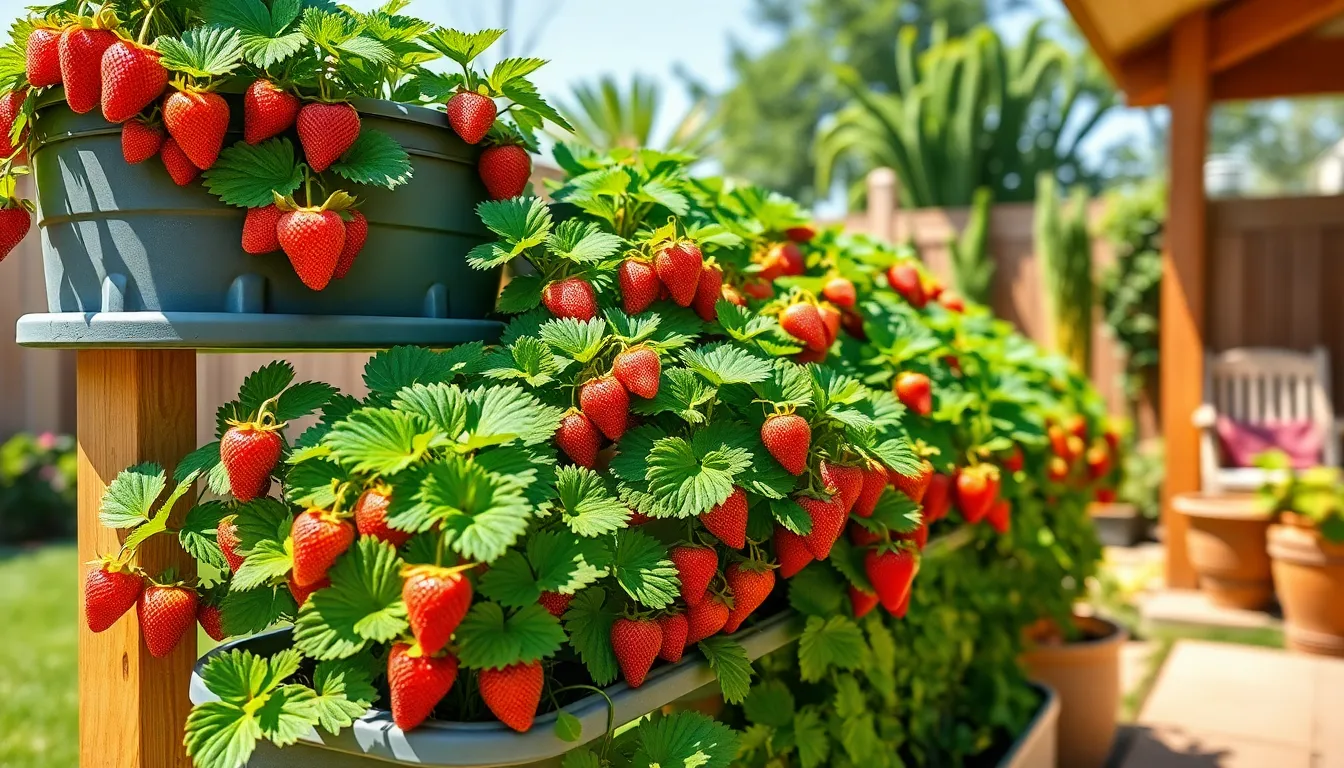
Now that we’ve covered the maintenance essentials, let’s explore innovative design approaches that’ll transform our vertical strawberry growing experience. These creative answers maximize both aesthetic appeal and practical functionality.
DIY Tower Gardens and Pallet Systems
Tower gardens using stackable planters offer one of the most effective approaches for vertical strawberry cultivation. The GreenStalk Vertical Planter system works exceptionally well for strawberries because it allows us to layer multiple plants while maintaining proper drainage and root space. We can create similar DIY versions using food-grade containers with drainage holes, stacking them to create towers that support 15-20 plants in just 2-3 square feet of ground space.
Pallet systems provide a cost-effective alternative that we can customize to fit any space. We transform wooden pallets by adding industry fabric backing and filling the slats with potting mix, creating vertical growing pockets for our strawberry plants. These repurposed pallet gardens can accommodate 12-16 plants per pallet while maintaining the 6-8 inch spacing our strawberries need.
PVC pipe towers deliver excellent results for gardeners seeking lightweight, portable options. We construct these systems using 6-inch diameter PVC pipes with holes cut every 8 inches, allowing us to plant strawberries at multiple levels. The hollow center serves as a watering column, ensuring consistent moisture distribution to all plants in the tower.
Plastic bottle gardens maximize recycling efforts while creating productive growing space. We cut 2-liter bottles in half, invert the top portion into the bottom, and fill with our lightweight potting mix. These compact units work perfectly for balconies and patios, with each bottle supporting one healthy strawberry plant.
Decorative Wall-Mounted Options
Living wall planters create stunning visual displays that combine beauty with berry production. We install modular planting pockets or felt systems directly onto walls or fences, transforming vertical surfaces into productive growing areas. These systems typically support 8-12 plants per square yard while creating an attractive green wall feature.
Hanging basket arrangements offer flexible positioning that we can adjust throughout the growing season. We mount brackets at varying heights along walls or pergolas, allowing us to create cascading displays of trailing strawberry varieties. The Rambling Cascade variety works particularly well in these setups, producing long runners that create natural curtains of fruit.
Trellis integrated planters combine support and growing space in elegant designs. We attach planter boxes directly to trellis frameworks, giving our strawberry plants both root space and climbing support for their runners. These systems work especially well with day-neutral varieties like Mount Everest, which produce fruit continuously throughout the season.
Window box vertical systems maximize limited space for apartment dwellers and urban gardeners. We stack multiple window boxes using bracket systems, creating vertical growing walls that can produce 15-20 pounds of strawberries in just 4 square feet of floor space. The Skyline variety thrives in these compact arrangements, producing sweet berries from spring through fall.
Troubleshooting Common Problems in Vertical Strawberry Growing
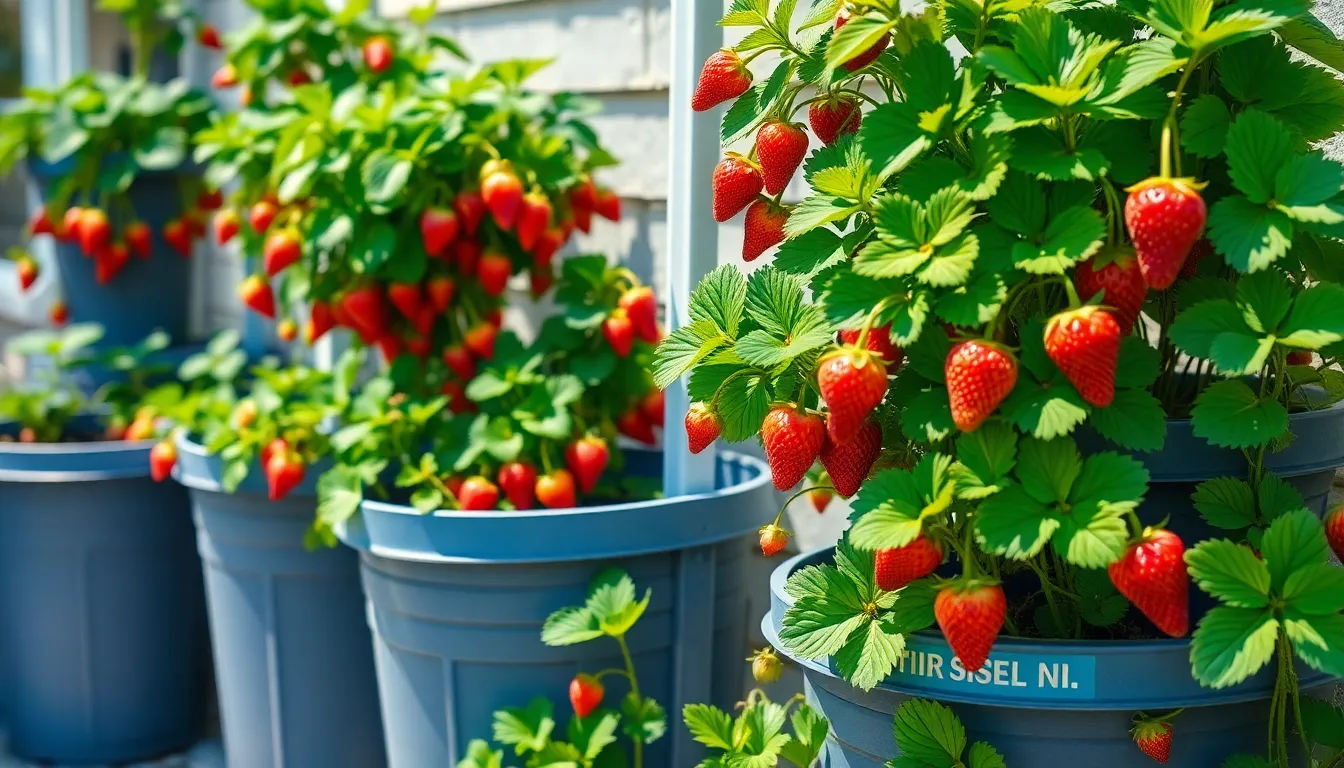
Even the most carefully planned vertical strawberry systems can encounter challenges that affect plant health and fruit production. We’ll guide you through identifying and resolving the most common issues to keep your vertical garden thriving.
Addressing Poor Fruit Production
Insufficient light exposure creates the most important barrier to healthy strawberry production in vertical systems. Most strawberry varieties require at least 6 hours of direct sunlight daily to develop proper fruit set and sweetness. We recommend rotating your stackable planters weekly to ensure all plants receive adequate light exposure, especially those positioned on the shadier sides of your tower.
Inadequate nutrition frequently causes weak flowering and poor fruit development in container grown strawberries. Balanced fertilizer applications become crucial since vertical systems can’t access ground nutrients like traditional gardens. We suggest using organic fertilizers every 2-3 weeks during the growing season, focusing on phosphorus rich options during flowering periods.
Incorrect planting depth prevents strawberry crowns from establishing properly and producing fruit. Plant your strawberry crowns at the precise level where only roots remain covered by soil, leaving the crown exposed to prevent rot. We’ve found that planting too deep suffocates the crown while planting too shallow exposes roots to drying out.
Overcrowding issues reduce individual plant productivity as strawberries compete for resources in limited container space. Space plants 8-12 inches apart in your vertical system to allow proper air circulation and root development. We recommend removing excess runners regularly to prevent overcrowding and direct energy toward fruit production.
Solving Watering and Drainage Issues
Overwatering problems manifest as yellowing leaves, root rot, and poor fruit quality in vertical strawberry systems. Ensure your containers have proper drainage by adding gravel or pebbles at the bottom of each planter level. We check soil moisture by inserting our finger 1-2 inches deep, watering only when the top layer feels dry to the touch.
Drainage complications occur frequently in stacked systems where water pools between levels. Install overflow holes 2-3 inches from the bottom of each container to prevent waterlogging while maintaining adequate moisture retention. We position these drainage points to allow excess water to flow naturally to the next level without flooding lower plants.
Underwatering stress shows through wilted leaves, poor fruit development, and increased susceptibility to pests. Monitor your vertical system daily during hot weather since container plants dry out faster than ground plantings. We maintain consistent moisture levels using drip irrigation systems that deliver water directly to root zones, reducing waste by 40-50% compared to overhead watering.
Uneven water distribution creates inconsistent growing conditions throughout your vertical tower. Position your watering source at the top level and allow gravity to distribute moisture downward through your system. We install adjustable flow emitters at each level to control water delivery and ensure every plant receives adequate hydration.
Conclusion
Vertical strawberry growing transforms how we approach berry cultivation by maximizing yields in minimal space. We’ve explored everything from system setup and variety selection to maintenance and troubleshooting – proving that anyone can create a thriving vertical garden.
Whether you’re working with a small balcony or looking to expand your current growing capacity we believe vertical systems offer unmatched efficiency. The combination of space savings better drainage and easier harvesting makes this method ideal for modern gardening challenges.
Your vertical strawberry garden awaits and with the right approach you’ll be enjoying fresh homegrown berries throughout the growing season. Start small experiment with different designs and watch your confidence grow alongside your harvest.
Frequently Asked Questions
What are the main benefits of growing strawberries vertically?
Vertical strawberry growing saves significant space while producing higher yields per square foot. It results in cleaner fruit, easier harvesting at comfortable heights, and improved air circulation for healthier plants. A single 6-foot tower can produce the same amount as a traditional 4×8 foot garden bed, yielding 2-3 pounds per square foot compared to 0.5-1 pound in ground gardens.
Which strawberry varieties work best for vertical growing?
Day-neutral varieties like ‘Mount Everest,’ ‘Skyline,’ and ‘Rambling Cascade’ are ideal for vertical systems. These cultivars provide continuous harvests throughout the growing season and thrive in contained environments. Compact and trailing varieties also work well, efficiently utilizing vertical space and allowing multiple plants in the same area for maximum yield.
How much water do vertical strawberry gardens need?
Vertical strawberry systems use 40-50% less water than conventional garden beds while maintaining optimal soil moisture. Drip irrigation systems are most effective, delivering water directly to roots and reducing waste. Self-watering containers with built-in reservoirs help maintain consistent moisture levels, allowing plants to draw water as needed.
What materials do I need to start a vertical strawberry garden?
Essential materials include stackable vertical planters or DIY systems like PVC towers, lightweight potting mix with proper pH levels, and sturdy support structures. You’ll also need grow bags for smaller setups, mounting brackets for stability, and irrigation components like drip emitters or self-watering systems for consistent moisture delivery.
How often should I fertilize vertical strawberry plants?
Apply diluted organic fertilizers weekly during peak growing periods. Fish emulsion, compost tea, and kelp meal are excellent organic options. Adjust feeding frequency based on plant growth stage and monitor soil moisture to prevent fertilizer salt buildup. Reduce feeding during dormant periods and increase during active growth and fruiting phases.
What are common problems in vertical strawberry gardens?
Common issues include poor fruit production due to inadequate light or nutrition, watering problems from improper drainage, and overcrowding reducing air circulation. Solutions include ensuring 6-8 hours of sunlight daily, maintaining consistent moisture without waterlogging, proper plant spacing, and regular monitoring for pests like aphids and spider mites.
How do I maintain my vertical strawberry garden throughout the seasons?
Regular maintenance includes pruning dead leaves and weak stems, managing runners to prevent overcrowding, and seasonal adjustments. Summer requires consistent watering and pest monitoring, autumn needs preparation for dormancy, and winter protection involves insulating plants from frost. Check plants weekly during growing season for optimal health.
Can I build a DIY vertical strawberry system?
Yes, DIY options include PVC pipe towers, pallet systems, plastic bottle gardens, and wooden tower structures. These cost-effective solutions can be customized to fit your space and budget. Ensure proper drainage, adequate spacing between plants, and stable mounting to support the weight of soil and mature plants.
